Humans have always had a desire to build big and reach for the stars. The sudden obsession with height began in 1884 when the Home Insurance Building in Chicago pierced the skyline and paved the way for the future of construction. Ever since then, construction companies all around the world have found ways to build bigger and to build smarter, with the title of ‘World’s Tallest Building’ becoming the ultimate goal.
The HIB Building rose to a comparatively modest 138 feet in comparison to the 2,720 feet Burj Khalifa that resides in Dubai. But how did we, as a race, reach such heights from such humble beginnings?
One of the most important and underestimated elements of constructing these marvels is skyline scaffolding. These structures act as a playground for the workforce that is tasked with building these monuments, so their importance must not be undermined.
Working at height is fraught with danger, so one would expect health and safety protocols to increase in correlation with the height of a building, right? Well, not all the time.
The construction of skyscrapers in Hong Kong could not be more different to the way we assemble our buildings back home. The rule book was seemingly tossed out of the window for Hong Kong, as their workers, dubbed ‘Spiders’, climb without harnesses up their bamboo frames. At face value, the idea seems ludicrous, but there is science behind the madness.
Bamboo is notoriously strong, and it is tied together with vines, contributing to the overall strength of the frames. Besides, this method of skyline scaffolding is traditional and is how many of the workers enter into the industry. To them, it is the only way they know.
The dangers of bamboo scaffolding are apparent, but the universal challenges of skyline scaffolding are heightened when constructing skyscrapers. The laws of physics state that the higher you climb, the windier it gets. That is what the architects and planners of the Khalifa had to contend with when plotting the world’s tallest building.
Thankfully for the scaffolders, there was a relatively straightforward way of combating this ever-present risk. Having learned from the mistakes of Taiwan which saw scaffolding ripped from the side of a building during a typhoon, constructors shaped the scaffolding to be partly inside the structure and not solely on the outside and clinging on. This made the metal frames a lot sturdier and a lot safer.
Unlike the spider-climbers in Hong Kong, workers on the Burj were clipped on to their frames at all times with harnesses, eliminating the most apparent danger of working 2,000-odd feet up in the sky.
It seems unfathomable to build taller than the Burj Khalifa, but as science and technology development, it is always possible. Besides; back in 1884, the people of Chicago, the United States, and the world, would never have dreamt of a building that peaks at 2,700 feet, so who knows?

